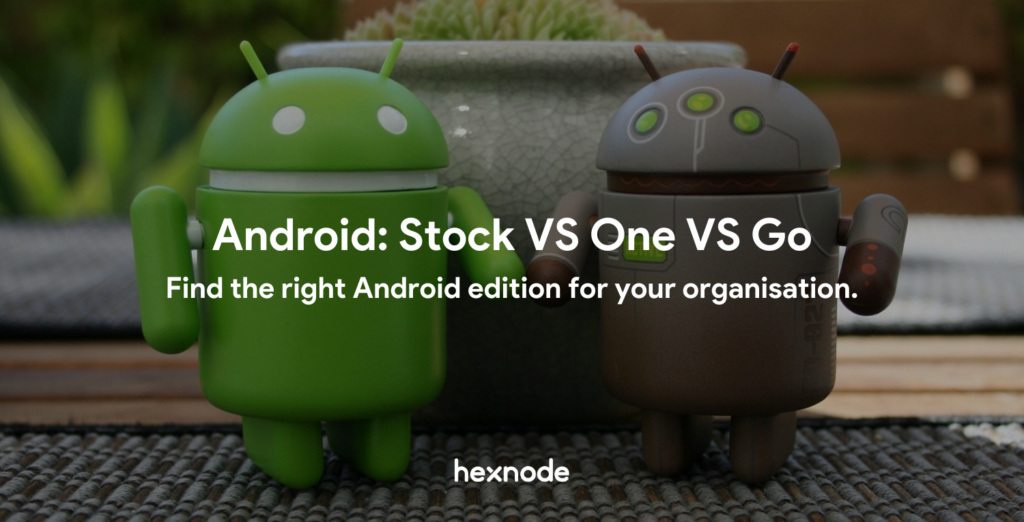Android is an omnipresent mobile Operating System, owned by Google, powering more than 2 billion mobile phones worldwide. This accounts for about 40% of all the devices, and it is high time we say, “hail Android!”. It had about 10 major updates and 17 versions to date and still, they have added in some extra editions. Stock Android, Android One, and Android Go are the best examples. Google has already given us the desserts, now a few more choices, wow!
The story of Android before all these seasonings was quite frankly, simple. The mobile manufacturers take Android source code from Google’s Android Open Source Program (AOSP) and build their customized Android-powered OS on this framework. They add their own apps, device drivers, a compactable UI, and their custom features and some bloatware to this chassis making it a better looking but a bit bulkier one. This may reduce resource availability, due to high storage or RAM usage by the pre-installed apps and bloatware, which in turn affect the performance. Higher these customizations, the larger the time taken by the Original Equipment Manufacturer (OEM) to release Google’s Android updates with their alterations thus leading to update delays.
Android One is a near Stock version of Android. It was released with the aim of exploring the new markets for Android in developing countries by offering them an excellent smartphone experience at a convenient price. This then evolved into something more, and Android Go is now released with the aim of continuing what Google planned with Android One. Here is a quick guide to help you decide between Stock Android vs Android One vs Android Go.
Stock Android
Stock Android is how Google wants Android to be. It is nothing but the untouched version (vanilla version) of Android from AOSP. Google installs this directly into their smartphones so that updates can be rolled out to these devices with no delays. Stock Android is limited to the features and apps developed by Google and does not include the OEMs customizations and bloatware, thus freeing up a lot of storage and RAM. Since there is less drama in the background, Stock Android can dedicate its available resources to whatever that is currently running, which makes it is faster.
Stock Android is the purest, minimal, or fundamental form of Android. Or simply put, Stock Android is what Google makes on its own hardware, i.e., the software shipped on their own devices. Stock Android is Google’s primary project of Android OS and has never been altered by any external parties as Google itself totally supports it. It is preferred mostly by tech enthusiasts as it is simple and easier and customizable. Google’s Nexus (discontinued in 2015), Pixel, and many other smartphones run on the Stock edition of Android.
If Stock Android is so great, then why go for other editions of Android?
As always, the economy is the villain, Stock Android is designed for high end smartphones and is constricted to the features developed by Google, but many prefer it otherwise. But with the customizations, arise hitches like update delays and bloatware. Google developed solutions to outweigh these, which are Android One and Android Go.
Android One
Google launched the Android one program in 2014 with the aim of releasing budget smartphones into emerging markets like India and other Asian countries. Android One is the collaboration of Google with other device manufacturers to produce mid-segment gadgets. With Android One, Google offers software development services to handset makers. Offering Android One, Google owes to manufacturers to send security patches and software updates directly to their handsets for a specific period of time. Android One is a kind of paid service. On partnering with Android One, OEMs must pay Google a particular amount for fulfilling their software needs. It was designed for entry level smartphones with minimum hardware capabilities but soon evolved to include mid-range and high-end smartphones.
Android One is not readily available in AOSP, and Google separately distributes Android One to the collaborating vendors. Google provides Android One as a service above AOSP to lend a hand to those OEMs who build quality hardware but lacks in their software and OS. Android One runs on non-Google devices with improved UI and security as it is not open source. Google mandates the hardware requirements for Android One so that their OS doesn’t have to be altered according to device specs. This completely hampers OEM’s sovereignty in building customized devices that set them apart in the market. But they can install some of their signature apps, for example, camera and Nokia support app on Nokia handsets. OEMs have to pay Google for providing them Android One OS and services like 2 years of software updates and 3 years of monthly security patches and upgrades.
Android One is the Stock Android for non-Google hardware users. Unlike custom Android, Android One has faster updates. Better battery performance, Google play protect, optimized Google Assistant, minimal bloatware, artificial intelligence from Google, more free storage space, and optimized RAM are some of its features.
Android Go
You already have Android One then why go for Android Go? Since Android One has deviated from the plan, Android Go is now destined to bring budget phones to the third world markets. It was introduced in 2017 in a limited number of low-end smartphones. The first Android Go edition was a trimmed down version of custom Android 8.1 Oreo. Now we also have a light-weight version of Android 9, Android 9 Pie Go.
Android Go is a cut-down version aimed explicitly at lower-end and less powerful devices. There won’t be many pre-installed apps, and all the already existing applications may be in their Lite or Go versions. In order to justify the low storage utilization, built-in Android Go apps compromise on their original features. Android Go is for lightweight performance on devices with low RAM and storage. All the core applications are designed in such a way that they make better use of resources while providing the same Android experience.
Android Go can be deployed in devices with RAM greater than 0.5 GB and storage as low as 8 GB. Google ships the Android Go OS to the OEMs which they modify according to their hardware specifications. The Android Go smartphones have minimum bloatware installed and have specially designed “Go apps”, a “Play Store Go” that suggests the best-suited apps for the device. It has a build-in data manager and has limited RAM consumption.
The optimized Go apps are Progressive Web apps in reality. This frees up about 50% of the storage space occupied by the apps in the device. App navigation is now 15% faster than normal Android. It also has features like Google play protect, optimized Google Assistant, etc.
What is Android Enterprise Recommended (AER)?

The AER is the Google recommended set of devices, EMMs, carriers, and MSPs best suited for the enterprise functions. Google has specified a complete set of requirements against which each device must be thoroughly vetted. The device that qualifies all these assessments will be certified and badged by Google as an AER device. The validation is done per device and not per OEM, so that the OEMs cannot submit one phone that is AER compatible, and badge that certificate on other phones which are not. For Example, if a phone brand has a handset that is AER certified, their other phones will have to go through the same verification procedures for AER badge.
Stock Android is not the finest choice for device management since Google only offers limited APIs that aids EMMs manage the device. In present devices, management is mainly possible through the APIs included by the OEMs. So, it is safe to assume that a mobile device manufactured and distributed by Google will have limited capability for Enterprise Device Management. But still many of the Stock Android devices have AER approval badge.
Android One is the best suited edition for Android Enterprise. It has got greater performance, dedicated hardware with Google charted stipulations, faster updates for 2-3 years directly from Google, and all its feature overlays with the AER specs. Many of the Android One devices like Nokia has made it to the AER list.
Android Go edition is the best possible alternative to a dedicated enterprise device with minimum specs and capabilities. Since most of the AER requirements released by Google are non-achievable for the typical low-end devices, the device’s AER compatibility is up to the OEMs. For example, an AER device must have a minimum of 32 GB storage and 2GB RAM, but an Android Go can have a memory as low as 0.5 GB and storage of 8 GB. So, for a device to be AER compatible, the manufacturer should follow the AER specifications on top of Android Go specifications.
Stock Android vs. Android One vs. Android Go – A little take away
Stock Android, Android One, and Android Go are different flavors of Android originated from Google and hence have many factors in common. Also, there are quite some differences which the manufacturers add as essences to make them unique.
| Stock Android | Android One | Android Go | |
|---|---|---|---|
| OS | Stock Android, untouched and directly deployed from AOSP. | Stock android with OS customisations. | Trimmed down version of custom android OS. |
| Performance | Better than other skinned versions of Android. | Not as efficient as stock but better than custom. | Better than skinned OS in less powerful devices. |
| OS Updates | Directly from Google without delay. | Untouched update deployment is in the hands of OEMs. | OEM releases Googles updates with their customisations. |
| Apps | Apps released by Google. | Apps released by Google + OEMs custom apps. | Optimised Go apps from Google + OEMs custom apps. |
| Bloatware | None. | Minimum or none. | Minimum or none. |
| Price | Comparatively high. | Medium. | Low. |
Android One comes with the most pre-installed apps while Android Go is having fewer installed apps coming with it. However, the bare minimum of apps is found in Stock Android devices. Some pre-installed apps like Camera can be different on each device depending on the hardware vendor. Google provides updates for Stock Android and Android One devices. For Android Go, all the customized updates and fixes are provided by the OEM itself.
Android One is the best fitted and most recommended devices for enterprise use. Entry-level devices from Android Go is also a viable option for small and medium business owners. Stock Android is a bit costlier option when compared to other alternatives. The prolonged reign of Android might contribute more to dedicated Enterprise Friendly devices.
If you’re having trouble choosing between Stock Android vs Android One vs Android Go, here is a quick way for you to decide. If you are looking to relate only with Google, go for Stock Android. If you want the pure Android experience but with the aid of an OEM vendor go for Android One. And if you’re looking for a low budget Android-like experience, go with Android Go.
Google has now taken the liberty of validating devices’ enterprise worthiness, thus reducing the corporate manager’s burden in selecting the best device that aligns with their expectations and potential budget. Through more integrations, AER might outweigh other device management platforms and earn a complete monopoly over the Enterprise Device Management. Samsung and Apple should soon come with a millennial solution to counter this Google-Android surge or else it is going to be pretty damn difficult to deal with!
Stock or One or Go, if you need help in managing your Android device (COPE or BYOD), do not hesitate to give Hexnode a call, we are well equipped to manage your machine.





